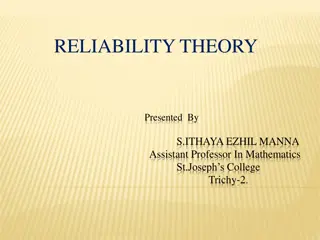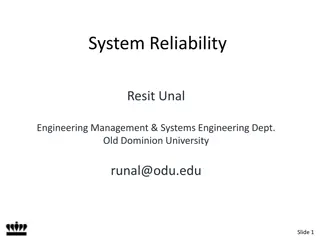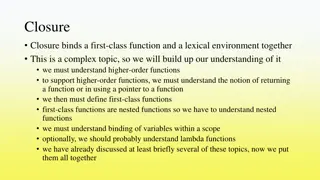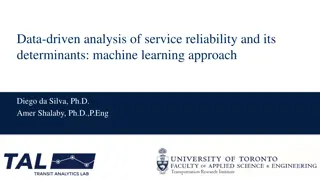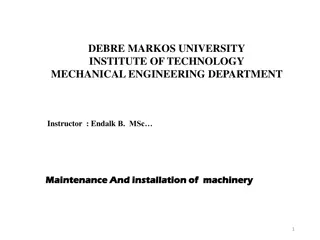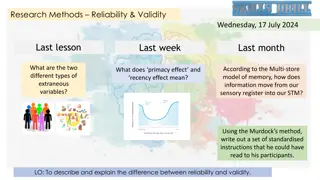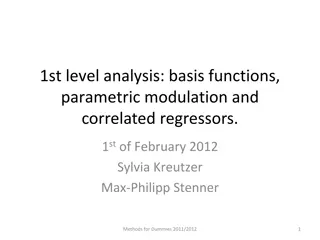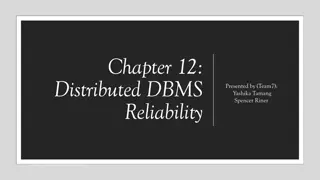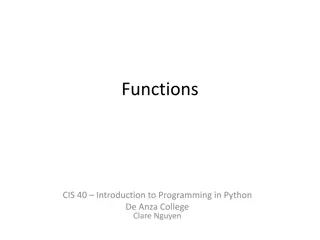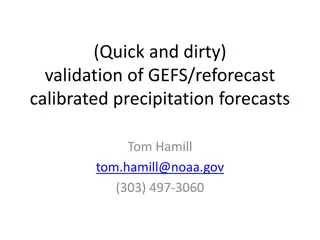Understanding Reliability Functions in Data Analysis
Reliability functions play a crucial role in data analysis, providing insights into the probability of success or failure over time. This chapter delves into topics like unreliability functions, derivation processes for reliability functions using distributions like exponential, Weibull, and normal. Learn how to define unreliability and reliability functions, their relationship, and the derivation process with the exponential distribution.
- Reliability Functions
- Data Analysis
- Exponential Distribution
- Weibull Distribution
- Normal Distribution
Download Presentation

Please find below an Image/Link to download the presentation.
The content on the website is provided AS IS for your information and personal use only. It may not be sold, licensed, or shared on other websites without obtaining consent from the author. Download presentation by click this link. If you encounter any issues during the download, it is possible that the publisher has removed the file from their server.
E N D
Presentation Transcript
Chapter Two Reliability Function Topics: Unreliability Function Reliability Function Reliability Function Derivation Process Exponential Distribution Weibull Distribution Normal Distribution
Unreliability Function The reliability function can be derived using the definition of the cumulative density function. Note that the probability of an event happening by time t based on a continuous distribution given by f(x), (or f(t) since our random variable of interest in life data analysis is time) is given by: One could also equate this event to the probability of a unit failing by time t, since the event of interest in life data analysis is the failure of an item.
This defines the unreliability function, Q(t), which is the probability of failure, or the probability that the time-to-failure is in the region of 0 (or ) and t. So, from the previous equation, we have:
Reliability Function In this situation, there are only two mutually exclusive situations that can occur: success or failure. Since reliability and unreliability are the probabilities of two mutually exclusive states, the sum of these probabilities is always equal to unity. So then: Where R(t) is the reliability function
Conversely, the pdf can be defined in terms of the reliability function as:
Relationship between the Reliability Function & CDF The following figure illustrates the relationship between the reliability function and the cdf, or the unreliability function.
Reliability Function Derivation Process We will illustrate the reliability function derivation process with the exponential distribution. The exponential distribution, the most basic and widely used reliability prediction formula, models machines with the constant failure rate, or the flat section of the bathtub curve. Most industrial machines spend most of their lives in the constant failure rate, so it is widely applicable.
The pdf of the exponential distribution is given by: = Failure rate (1/MTBF, or 1/MTTF) t = operating time, life, or age, in hours, cycles, miles, actuations, etc. e = base of the natural logarithms (2.718281828) The exponential PDF represents a random occurrence over time Hence, the reliability function for the exponential distribution is:
As is decreased, the distribution is stretched out to the right, As is increased, the distribution is pushed toward the origin. This distribution has no shape parameter as it has only one shape, (i.e., the exponential, and the only parameter it has is the failure rate, ). The location parameter, , is zero.
The distribution starts at t = 0 at the level of f(t = 0) = and decreases thereafter exponentially and monotonically as t increases, and is convex. As , t approaches infinity, f(t) approaches zero. The pdf can be thought of as a special case of the Weibull pdf with = 0 and = 1 and .
Example Following time to failures of an item are exponentially distributed: 75, 100, 70, 130, and 125 (in hours) Calculate the reliability of the item for an operating period of 100 hours Solution R(t) = ? ? t = period of operation ? = failure rate
? ? = ???? MTBF = ??+???+??+???+??? = 100 ? ? ? = ??? = 0.01 R(100) = ? ?.?? ??? = 0.37 F(t) = 1- R(t) = ? 0.37 = 0.67
Operating optimum time when reliability target is 50% R(t) = ? ?? 0.5 = ? ?.??? ln0.5 = ??? ?.??? ln0.5 = ?.??? t =-?? ?.? ?.?? = ?.??? ?.?? = 69.3 hours
Required MTBF when reliability target is fixed at 50% for an operating time of 100 hours Solution R(t) = ? ?? 0.5 = ? ???? ? = 0.00693 ???? = ? ? ? = ?.????? = 144.3 hours
The 2-Parameter Exponential Distribution The 2-parameter exponential pdf is given by: Where is the location parameter. The location parameter, , if positive, shifts the beginning of the distribution by a distance of to the right of the origin, signifying that the chance failures start to occur only after hours of operation, and cannot occur before The scale parameter is The exponential pdf has no shape parameter, as it has only one shape. The distribution starts at t= at the level of f(t= ) = and decreases thereafter exponentially and monotonically as t increases beyond and is convex. As , t approaches infinity, f(t) approaches zero.
The Mean or MTTF The mean, or mean time to failure (MTTF) is given by: Note that when = 0, the MTTF is the inverse of the exponential distribution's constant failure rate. This is only true for the exponential distribution. Most other distributions do not have a constant failure rate. Consequently, the inverse relationship between failure rate and MTTF does not hold for these other distributions
Different other distributions exist, such as the Weibull, normal, etc., and each one of them has a predefined f(t). These distributions were formulated by statisticians, mathematicians and/or engineers to mathematically model or represent certain behavior. For example, the Weibull distribution was formulated by Walloddi Weibull and thus it bears his name. Some distributions tend to better represent life data and are most commonly referred to as lifetime distributions.
However, the exponential distribution and the Weibull distribution are the two most widely applied distributions to reliability engineering.
For the derivation of the reliability functions for other distributions, including the Weibull, normal and lognormal, see ReliaSoft's Life Data Analysis Online at http://reliawiki.org/index.php/Life_Data_Analysis _Reference_Book.



